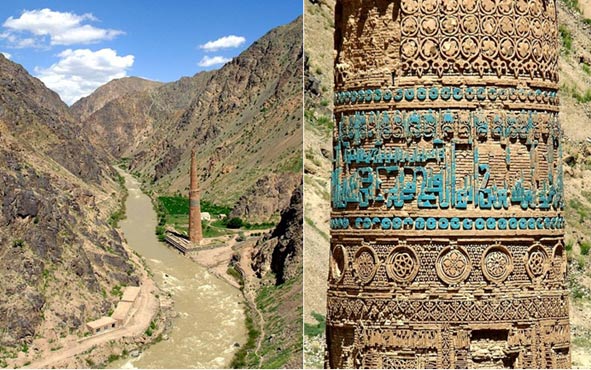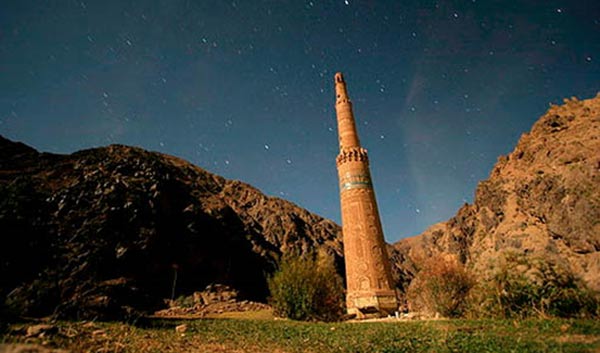The Minaret of Jam – Last Monument of the Lost City of Turquoise Mountain
The Minaret of Jam is a 12 th century tower located where the Hari River meets the River Jam in the Sharhrak district of Afghanistan. Standing 65 meters above the valley, it is the only surviving monument of the 12 th century Ghurid Empire, Afghanistan’s last great indigenous empire, now known as the Lost City of Turquoise Mountain. It remains as a lasting legacy of a period in which Jews, Christians, and Muslims lived side-by-side in harmony, united by their commonalities rather than divided by their differences.
The Turquoise Mountain (Firozkoh) is the legendary lost Afghan capital of the Middle Ages. Reputedly a prospering multicultural centre and one of the greatest cities of its age, it is also believed the ancient city was the home of a Jewish trading community, documented by inscriptions on tombstones found in the 1950s. Ögedei Khan, son of Genghis Khan, destroyed the capital in the early 1220s, marking its loss to history.
The Minaret of Jam rests on an octagonal base and consists of four cylindrical shafts resting on top of one another, and getting progressively smaller as they get higher. It is made of fired brick and lime mortar, with two wooden balconies and a lantern at the top. Its exterior is decorated in exquisite detail, covered with brick, stucco, and glazed tiles, which contain intricate inscriptions of alternating bands of kufic and naskhi calligraphy, geometric patterns, and verses from the Qur'an.

The Minaret of Jam, Afghanistan (Public Domain)
The actual dating of the minaret is unclear. Written in Arabic, it could read 1193/4 or 1174/5. The unclear dating makes it difficult to determine the reason that the minaret was erected. It could have been built to commemorate the Ghurid sultan Ghiyas ud-Din’s victory over the Ghaznevids in 1186 in Lahor. However, in the 1970s, British Archeologist and Director of the British Institute of Afghan Studies Dr. Ralph Pinder-Wilson conducted a major study of the minaret, concluding that it was built to commemorate the victory of Mu'izz ad-Din, over Prithviraj Chauhan.

Timurid conqueror Babur advancing through the mountains to Kabul, 1502. The Minaret of Jam can be seen in the background. Image source: Wikipedia
It has been speculated that the minaret was once attached to a mosque that was washed away in a flash flood, prior to the Mongol sieges. Archaeologists have found physical evidence that a large courtyard building once existed beside the minaret. In Central Asia, it was common to build single, massive towers as a sign of political power. It is said that the minaret is both strikingly large and visible due to its size, yet mostly concealed from the world, due to its location within the valley.
The minaret was actually forgotten for many centuries. It was rediscovered in 1886 by Sir Thomas Holdich, forgotten again, and rediscovered in 1957. The religious aspects of the minaret are very apparent. One visitor notes: “This chapter, called Maryam, tells of the Virgin Mary and Jesus, both venerated in Islam, and of prophets such as Abraham and Isaac. It's a text that emphasises what Judaism, Christianity and Islam have in common, rather than their differences. It seems the Ghorids placed the text here to appeal for harmony and tolerance in the land, a message that is more relevant now than ever.”
Visitors to the Minaret of Jam can ascend to the top using a set of stairs shaped like a double-helix. The steps first end in an open chamber, where visitors can look out over the rivers and nearby scenery. A second set of stairs can be taken to the top to view the lantern gallery. However, very few visitors ever make it to the minaret, as it is a long, difficult journey, filled with many dangers and threats, including local bandits, abduction, or execution by insurgents. In Afghanistan, the Minaret of Jam is certainly located in the middle of a very dangerous area of today’s world.

Inside the minaret is a set of stairs shaped like a double-helix. Image source: Bestourism
The Minaret of Jam was declared to be a UNESCO World Heritage Site in 2002. It is currently threatened by seepage from the waters of the rivers on which it stands, erosion, vibrations from road-construction nearby, threats of intentional destruction, and the continuation of illegal archeological digs. With no extensive restoration taking place since the minaret was constructed, and little funding to conduct any repairs, it is unsure whether the minaret can be preserved, or if it’s doomed to crumble.
Numerous archaeological remains of the lost city of Turquoise Mountain were once found around the Minaret, including marble friezes, ivory chess sets, gold, and pottery, but with the Allied invasion of Afghanistan in 2001, the Taliban's hold on ancient places broke, leaving the Ghor Province open to pillagers. After the invasion, hundreds of diggers flocked to the Minaret to uncover lost gold. And uncover they did. There remains very little of the city, and many of the treasures that were in the city have now been sold in markets in Herat, Kabul, and Teheran.
"The villagers had clearly succeeded where the archaeologists had failed and had uncovered an ancient city," said Rory Stewart, Director of the non-profit Turquoise Mountain Foundation. The Foundation was founded to create jobs, teach skills and foster national identity. It is based in Kabul, and aims to regenerate historic urban areas, renew traditional Afghan arts and architecture, and promote sustainable development of Afghanistan’s craft industry.
Featured image: The Minaret of Jam, Afghanistan. Credit: Keith Mellnick
Sources:
The Minaret of Jam, Afghanistan – Amusing Planet
The Minaret of Jam – Lonely Planet
Under Threat: The Magnificent Minaret of Jam – Culture in Development
Afghan historic minaret of Jam 'in danger of collapse' - BBC
Meeting with a Minaret – The Guardian
The Mysterious Minaret of Jam – Dark Roasted Blend
Minaret of Jam – New World Encyclopedia
By M R Reese


















Comments
Looks like an ancient rocket, which never got to launch :(
Let it remain untouched, as mans violent past, Still today sustains. It's inscriptions are largely ignored, greed, war and ignorance continue, man is always quick to judge and slow to change. But this monument is a true test If his created Stone, will outlast him; or will man outgrow his, inner most demons ?
I sincerely hope terrorists of any kind, don't get to it and raise it :(
Remaining untouched, it seems it has, everlasting luck ! So far, And it has made it into Ancientness :)
If only it's builders could see it now...